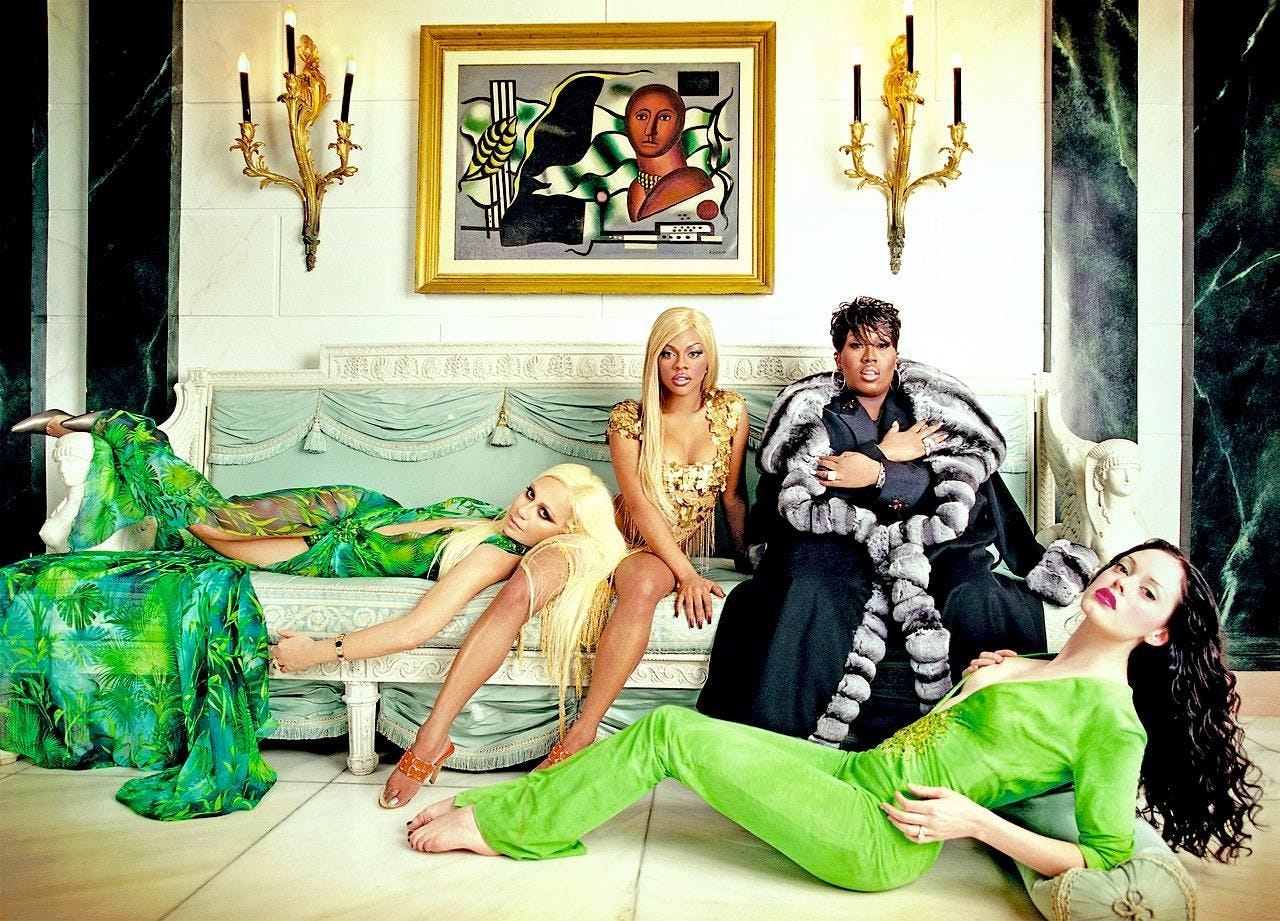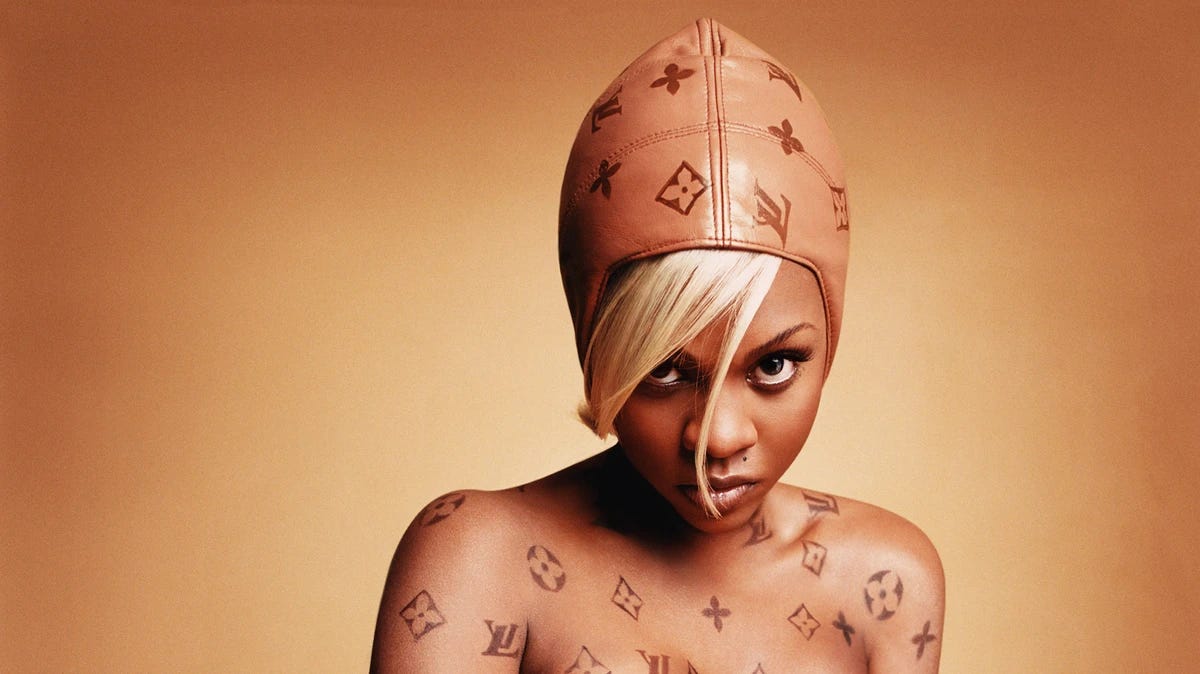Kim Deserves EVERY Flower, and MORE
On the occassion of her 50th birthday, let's remember that nobody rode the 90s "high fashion x hip hop" wave better than Kimberly Denise Jones

Who personifies 90s fashion better than Lil’ Kim? The pint-sized Brooklyn phenom rocked luxury brands with just as much confidence as her iconic verses— unapologetically and in a way that was entirely and uniquely KIM. For that reason, among many others, when we talk about fashion icons, we need to include Kim.
And I don’t mean just “90s fashion” icons, “Black fashion” icons, or “hip hop fashion” icons. I mean icons, no qualifiers. By the time Kim’s star was rising in the mid-90s, mainstream (read: white) fashion had swung a full 180 from the logomania of the previous decade, and minimalism was in. Fashion editors raved about the understated style of women like Carolyn Bessette-Kennedy and Kate Moss, cementing them as international fashion icons. But what about Kim? Surely, if Carrie Bradshaw’s pink tutu can be cited as a fashion moment for the ages, Lil’ Kim’s custom pink Versace look at the 1999 Met Gala deserves the same treatment. Kim sat front row at Versace, is a long-time Marc Jacobs muse and was once painted head-to-toe in the Louis Vuitton logo in a now-iconic photo by David LaChapelle.
In honor of the Hard Core rapper’s 50th birthday, I wanted to examine Lil’ Kim’s impact on me, today’s rap girls and the entire fashion industry. It’s past time we rewrite the narrative of Lil’ Kim, THE fashion icon.
From Brooklyn to Paris—Fashion’s Queen Bee is Born
“So I look sick in my six with my Christian LaCroix,” I was seven years old when Kim hipped me to the French Haute Couture house on one of the breakout hits from her 1996 debut album, Hard Core. While “Crush on You” is a fantastic song, the music video propelled it to legendary status. Kim donned four head-to-toe color-coded ensembles while rapping about a life of luxury and excess. Almost three decades later, the video is still inspiring people. Just a few years ago, Gen Z paid homage with a TikTok trend based on Kim’s colorful outfits.
Yves Saint Laurent said it best, “fashions fade, style is eternal,” and two decades ain’t nothing to sneeze at. 1996 also marked the year I asked for my first issue of Vogue magazine, and my love of luxury fashion was born. I fell in love with the labels; Dior, Fendi, Gucci, Pucci, Missoni. However, while I liked reading Vogue, none of the women in those designers looked like me or anybody I knew, but Lil’ Kim did. And that had a profound effect on my love of fashion.
Following the success of Hard Core, Kim became a fashion-it girl, partying with Giorgio Armani and forming a close friendship with Donatella. Kim’s unique and individual style hit a chord with designers. This also followed the intense interest in the 90s “urban look” when heritage luxury fashion houses started to lean into the trends of hip-hop and Black Americans.
From Rapper to Muse
By the time the music video for 1997’s woman empowerment anthem, “Not Tonight (Remix),” came out (featuring Lisa “Left Eye” Lopes, Angie Martinez, Da Brat and Missy Elliot in coordinating white outfits on a beach— their combined slay!) Kim was already a bonafide fashion star. She walked red carpets in white flapper-esque diamante dresses and almost stole the show in Missy Elliot’s “The Rain (Supa Dupa Fly)” video, appearing in Chanel-emblazoned suspenders that have been on MY wishlist for damn near 30 years (though we all know nothing in that video topped Missy’s patent leather blow up suit). Even as a kid, I could tell there was something special about what Kim was doing. At the time, I didn't understand the rhetoric around her decisions to be her authentic self and take on the misogyny that still permeates hip-hop culture. Nor did I comprehend how revolutionary it was that a Black woman from Brooklyn took the predominantly white, European fashion world by storm. And not by fitting in or demuring her style but by incorporating their looks into her world.
Why Isn’t Kim Receiving Her Fashion Flowers?

Even without that context, Lil’ Kim’s fashion still resonated with me, and I think it’s because, like Kim, I love fashion. While some might have just liked the wealth and prestige those designer labels represented, Kim clearly loved the art of fashion and wasn’t afraid to experiment and stand out. It wasn’t just a garment when it came to her look—it was theater, a performance. The outfits, the hair, the shoes– Kim was truly ahead of her time, nipple pasties and all.
So why isn’t Kim mentioned in some of those “fashion icon” lists that routinely pop up?
Originality? Check.
Inspiring generations after her? Check.
A Marc Jacobs muse? Check.
When we can wax poetic about Audrey Hepburn and Hubert de Givenchy, why not do the same for Lil’ Kim and long-time stylist and collaborator Misa Hylton? They have certainly earned their place in the fashion pantheon.
The answer, to me, is pretty apparent: Kim’s sartorial choices are less Parisian gamine and more, for lack of a better word, Black. Lil Kim reflects her culture and environment: the different-colored wigs, coordinating hues, furs and glamour. Even though I was a little girl, I remember Black women of the 90s in coordinated sets (LONG before Fashion Nova) and bright, intricately styled hair. Women who sported nighttime looks in glittering lurex fabric or coordinated denim paired with tinkling gold anklets, nose rings and conspicuously-colored acrylic nails. They looked damn good, but at the time, that wasn’t what fashion was doing, so those women, trendsetters that they were, went largely unnoticed or were deemed fashion faux pas’, but we know differently today. Instabaddies and high fashion alike have adopted so many of those archival looks, often without giving proper credit to the originators (“Ghetto until proven fashionable,” indeed). Fashion continues to erase the impact Black women have, and Lil Kim isn’t exempt from that.
But her impact is everywhere - from Beyonce’s 2017 Lil’ Kim Halloween cosplay to the skittle-hued wigs Kylie Jenner wore for years. Lil’ Kim’s entire 1995-1998 fashion catalog could drop in an Instagram boutique tomorrow, and the girls would go feral. Her style is, in every sense of the word, “timeless.” No, it isn’t a Saint Laurent le smoking jacket or an Oleg Cassini dress, but it is just as valid. And I don’t think it’s too farfetched to say that Lil’ Kim belongs in the “best dressed” archives alongside Jackie O, Sarah Jessica Parker, Tilda Swinton and others.
And that’s not even touching on the women rappers that followed in Kim’s wake: Nicki Minaj, Cardi B, Saweetie, Doja Cat, Megan the Stallion, and Kash Doll, to name a few. Of course, each woman is an individual with her own style, but anybody can see hues of can see Kim in there. It’s the bold wigs, the sexy and theatrical costumes, and the juxtaposition of explicit lyrics against the backdrop of luxury. Lil’ Kim’s debut changed the way women rappers looked, and we continue to see that in the femcees of today.
More than that, Lil’ Kim had a profound impact on girls like me. She’s one of the reasons I’m a fashion writer. The seeds she planted decades ago grew into one of my greatest passions, and I know I’m not the only one who believes her icon title is more than deserved. A 2017 article by The Fashion Law openly questioned why Lil’ Kim has never been awarded the coveted CFDA Fashion Icon award, stating, “[it is ]almost senseless that Kim has not stormed the stage to accept the award already; she is certainly deserving for a number of reasons, not least of which is her enduring personal style, which is arguably just as influential in 2017 as it was when Kim first broke into the music industry in 1995…” and they’re right. Lil’ Kim’s style remains as relevant, groundbreaking and exciting as when she first debuted in 1995, and if that isn’t the definition of a fashion icon, then I don’t know what it is.
What I do know is that WE, the Black girl fashion congregation, have been aware of Kim’s G.O.A.T. status for years now, and it is past time the rest of the fashion industry caught up.
Lil Kim is a fashion icon—no qualifier necessary. You know it, I know it, the world knows it—now give her her flowers.
I sincerely hope you enjoy, Ok, So Here’s My Theory. This is a totally free publication. If you do and you want to support my work, please subscribe, share with friends and family, and if you feel particularly inspired, you can buy me a coffee.






Love this! Kim deserves so much credit for our music and fashion today ❤️